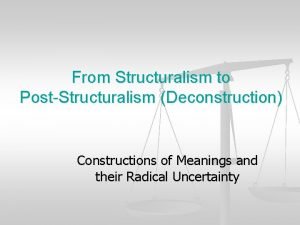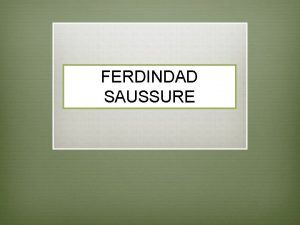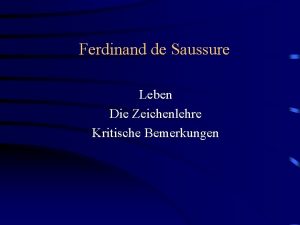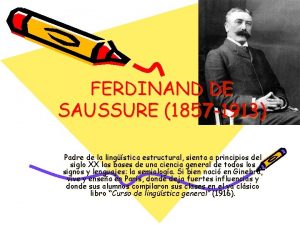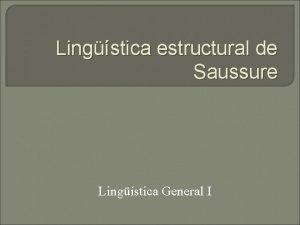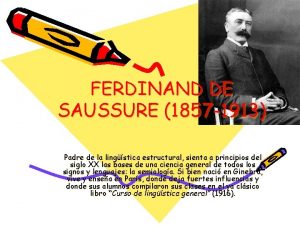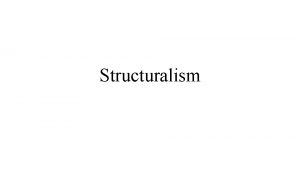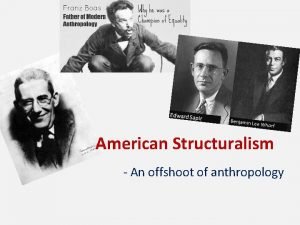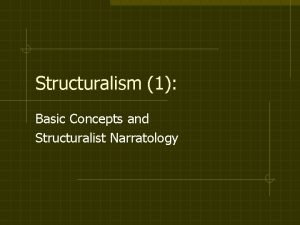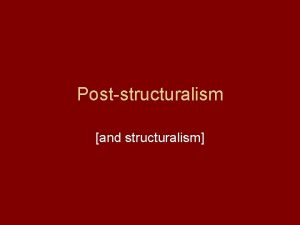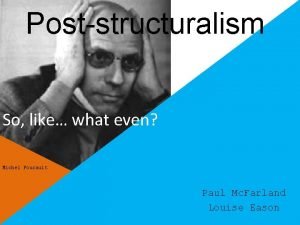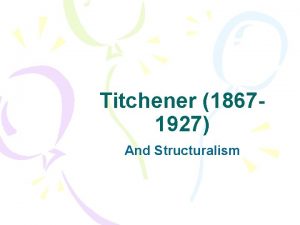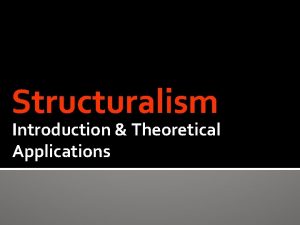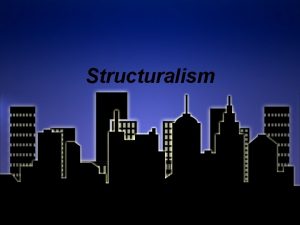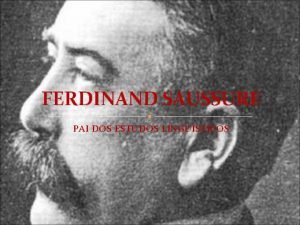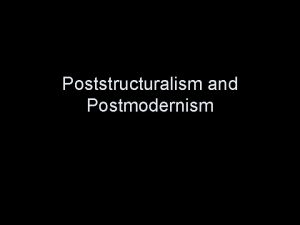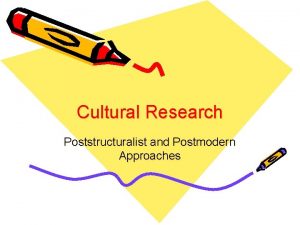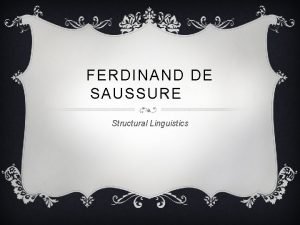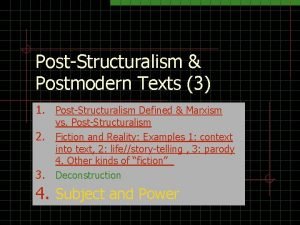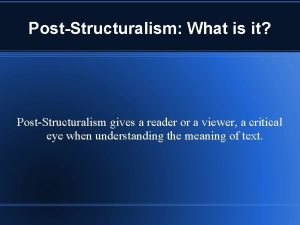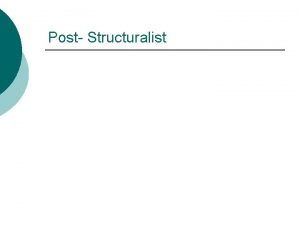Poststructuralism and structuralism Structuralist Linguistics Ferdinand de Saussure
![Post-structuralism [and structuralism] Post-structuralism [and structuralism]](https://slidetodoc.com/presentation_image/04b97cf0e085afa49c3bd64fc1b32419/image-1.jpg)












- Slides: 13
![Poststructuralism and structuralism Post-structuralism [and structuralism]](https://slidetodoc.com/presentation_image/04b97cf0e085afa49c3bd64fc1b32419/image-1.jpg)
Post-structuralism [and structuralism]

Structuralist Linguistics Ferdinand de Saussure A Course in General Linguistics (1916) • Posthumously published collection of lectures • Considered the foundation of modern linguistics

Saussurian (Structuralist) Semiotics • Sign: the basic unit of language (a word, but also applicable to nonverbal narrative, theories, images, etc. ). A sign is composed of a signified and signifier. • Signifier: the sound and image of the sign. • Signified: the concept associated with the signifier. • Referent: the idea or object outside of language to which a sign refers.

Saussure said that the sign is arbitrary: There is no logical or necessary relationship between the signifier and signified or between a sign and its referent. Cultural conventions designate these associations. The difference between signs give them meaning.

Structuralism (peaked in 60 s) Human knowledge and experience is not intelligible except through networks of relationships of signs and sign systems (structures). A sign (word, song, image) gets its meaning only in relation to other signs in a sign system. Areas of knowledge can be unified through structures/networks of signs.

Post-structuralism (late 60 s) If signs are arbitrary, then signs are only and always about relationships with other signs. Language is primarily about language, not about the extra-linguistic referents of language. Language and signs are thus freed from reference [and capable of transgression, political instabilities, revolutionary intent].

1926 -1984 French historian, theorist, founder of a “discursive practice” Michel Foucault “What Is an Author? ” (1969)

Main Points of Essay Premise: The author’s “disappearance” (“death”): 1. Today’s writing “is an interplay of signs arranged less according to its signified content than according to the very nature of the signifier” (890). The “writing subject” is irrelevant to this. 2. “The writing subject cancels out the signs of his particular individuality” (891). � Think modernism.

2 ways we conceal the true meaning of the author’s disappearance: 1. We deny that the idea of a unified “work” is arbitrary (891). 2. We have pseudo-religious ideas about the nature of writing, that aesthetic works will outlive, transcend, exceed authors: “the notion of writing seems to transpose the empirical characteristics of the author into a transcendental anonymity” (892).

What can we learn from the author’s absence/disappearance? • An author’s name is an arbitrary sign-its signified, its implied presence in a text, its explicit presence in the text are all arbitrarily associated (892 -3). • An author’s name “marks off the edges of the text, ” designates its meaning (893).

The “author function” is Foucault’s way to address this problematically “disappeared” author. The author function characterizes “the mode of existence, circulation, and functioning of certain discourses within a society” (894). It describes and prescribes a work’s cultural context.

4 characteristics of the a. f. 1. Discourses are objects of appropriation; a. f. indicates ownership and $ status (894). Think anti-capitalism, I. P. and copyright law. 2. The a. f. is historically & culturally relative (894). Think post-structuralism. 3. The a. f. results from a complex social, cultural, economic system not an individual “genius” (895). Think anti-Romanticism. 4. The a. f. does not refer to an individual (895). Think anti-liberal bourgeois subject.

“The author is not an indefinite source of significations which fill a work; the author does not precede the works, he is a certain functional principle by which, in our culture, one limits, excludes, and chooses; in short, by which one impedes the free composition, decomposition, and recomposition of fiction. . The author is therefore the ideological figure by which one marks the manner in which we fear the proliferation of meaning. ” (899)
 Post structuralism and structuralism
Post structuralism and structuralism Aportes de ferdinand de saussure a la linguistica
Aportes de ferdinand de saussure a la linguistica Ferdinand de saussure sprachtheorie
Ferdinand de saussure sprachtheorie Padre de la lingüística
Padre de la lingüística Aporte de ferdinand de saussure
Aporte de ferdinand de saussure Ferdinand de saussure (1857-1913)
Ferdinand de saussure (1857-1913) Structuralism
Structuralism Anthropology
Anthropology Structuralism in linguistics
Structuralism in linguistics Structuralism in linguistics
Structuralism in linguistics Language
Language Difference between linguistics and applied linguistics
Difference between linguistics and applied linguistics Post structuralism in architecture
Post structuralism in architecture Post structuralism in literature
Post structuralism in literature
